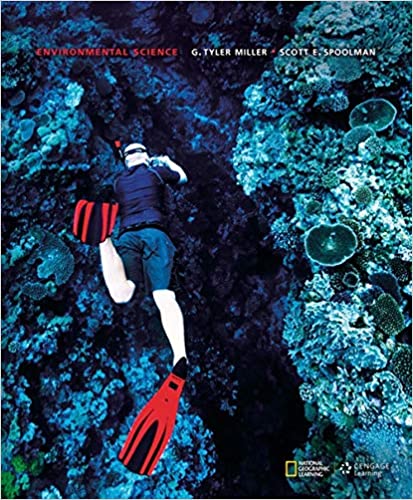
Environmental Science 15th Edition by Scott Spoolman,Tyler Miller
Edition 15ISBN: 978-1305090446
Environmental Science 15th Edition by Scott Spoolman,Tyler Miller
Edition 15ISBN: 978-1305090446 Exercise 1
ESTIMATING EXTINCTION RATES
Scientists who try to catalog extinctions, estimate past extinction rates, and project future extinction rates face three problems. First, because the natural extinction of a species typically takes a very long time, it is difficult to document. Second, we have identified only about 2 million of the world's estimated 7-10 million and perhaps as many as 100 million species. Third, scientists know little about the ecological roles of most of the species that have been identified.
One approach to estimating future extinction rates is to study records documenting past rates at which easily observable mammals and birds have become extinct. Most of these extinctions have occurred since humans began to dominate the planet about 10,000 years ago, when we began the shift from hunting and gathering food in the wild to growing our food and living in towns and cities. This information can be compared with fossil records of extinctions that occurred before that time.
Another approach is to observe how reductions in habitat area affect extinction rates. The species-area relationship, studied by Edward O. Wilson (see Individuals Matter 4.1, p. 67) and Robert MacArthur, suggests that, on average, a 90% loss of land habitat in a given area can cause the extinction of about 50% of the species living in that area. Thus we can base extinction rate estimates on the rates of habitat destruction and degradation, which is increasing around the world.
Scientists also use mathematical models to estimate the risk of a particular species becoming endangered or extinct within a certain period of time. These models include factors such as trends in population size, past and projected changes in habitat availability, interactions with other species, and genetic factors.
Researchers are continually striving to get more and better data and to improve the models they use in order to make better estimates of extinction rates and to project the effects of such extinctions on vital ecosystem services such as pollination ( Core Case Study ). These scientists contend that our need for better data and models should not delay our acting now to keep from hastening extinctions and the accompanying losses of ecosystem services through human activities.
Critical Thinking
Does the fact that extinction rates can only be estimated make them unreliable? Why or why not?
Scientists who try to catalog extinctions, estimate past extinction rates, and project future extinction rates face three problems. First, because the natural extinction of a species typically takes a very long time, it is difficult to document. Second, we have identified only about 2 million of the world's estimated 7-10 million and perhaps as many as 100 million species. Third, scientists know little about the ecological roles of most of the species that have been identified.
One approach to estimating future extinction rates is to study records documenting past rates at which easily observable mammals and birds have become extinct. Most of these extinctions have occurred since humans began to dominate the planet about 10,000 years ago, when we began the shift from hunting and gathering food in the wild to growing our food and living in towns and cities. This information can be compared with fossil records of extinctions that occurred before that time.
Another approach is to observe how reductions in habitat area affect extinction rates. The species-area relationship, studied by Edward O. Wilson (see Individuals Matter 4.1, p. 67) and Robert MacArthur, suggests that, on average, a 90% loss of land habitat in a given area can cause the extinction of about 50% of the species living in that area. Thus we can base extinction rate estimates on the rates of habitat destruction and degradation, which is increasing around the world.
Scientists also use mathematical models to estimate the risk of a particular species becoming endangered or extinct within a certain period of time. These models include factors such as trends in population size, past and projected changes in habitat availability, interactions with other species, and genetic factors.
Researchers are continually striving to get more and better data and to improve the models they use in order to make better estimates of extinction rates and to project the effects of such extinctions on vital ecosystem services such as pollination ( Core Case Study ). These scientists contend that our need for better data and models should not delay our acting now to keep from hastening extinctions and the accompanying losses of ecosystem services through human activities.
Critical Thinking
Does the fact that extinction rates can only be estimated make them unreliable? Why or why not?
Explanation
Yes. The fact that extinction rates can ...
Environmental Science 15th Edition by Scott Spoolman,Tyler Miller
Why don’t you like this exercise?
Other Minimum 8 character and maximum 255 character
Character 255


